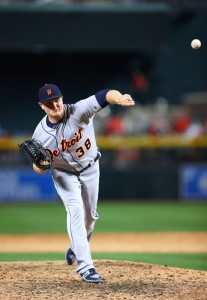Have the Cubs emptied their farm in a worrying way? It’s not quite that simple, Patrick Mooney of CSN Chicago writes. With a youthful and controllable core of position players, GM Jed Hoyer says, “we’re an incredibly healthy organization from a young-talent standpoint.” While the front office will still need to replenish the ranks in the long run, despite lower draft positions and new limitations on international spending, it does indeed seem reasonable not to focus too much on the fact that the club has lost so much from the top of its system (much of it to graduation, not trade).
- One player that just moved out of the Chicago system — new Tigers corner infielder Jeimer Candelario — is heading right up to the majors, as Anthony Fenech of the Detroit Free Press writes. While GM Al Avila says he hopes Candelario will push for a regular role next year, it seems he won’t shoulder that burden in his first MLB stint with his new club. Indeed, he may just function as a bench piece for the time being, manager Brad Ausmus suggests and Evan Woodberry of MLive.com tweets.
- The Twins have moved lefty Stephen Gonsalves up to Triple-A, per an announcement from the team’s top affiliate. The 23-year-old southpaw entered the season as a consensus top-100 prospect leaguewide, and has responded by continuing to dominate the opposition at Double-A — as he did in a half-season there last year. Given the pitching struggles at the MLB level in Minnesota, it’s fair to wonder whether Gonsalves could become an option down the stretch, either to boost the staff if the team stays in the Wild Card hunt or merely to give him a look to see if he’s an option for 2018.
- Meanwhile, the Twins can breathe easy after seeing Miguel Sano worryingly take a pitch off his hand. As Mike Berardino of the St. Paul Pioneer-Press reported yesterday, the young slugger received a clean bill of health after undergoing an MRI and CT scan. Sano has missed the last three games but will presumably be able to return once the pain and swelling subside.
